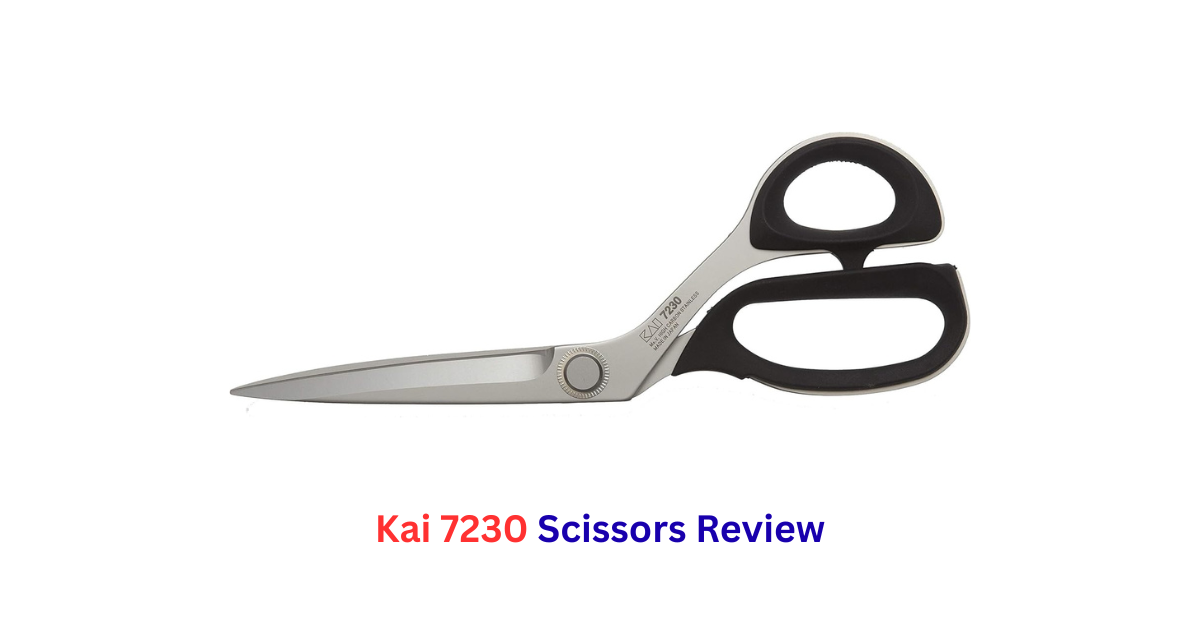
KAI Scissors 7230 9in Shears, Stainless Steel
Check PriceHave you ever picked up a tool that instantly made you question every other version you’ve used before? My kai 7230 scissors review experience was exactly that kind of revelation. When I first tested these shears, I genuinely stopped mid-cut, amazed at how different they felt from my previous scissors.
These Japanese sewing scissors have earned an impressive 4.9 out of 5 stars, with 100% of users saying they would recommend them. Furthermore, kai fabric scissors are crafted from high-carbon stainless steel, allowing them to be sharpened at a steeper angle while maintaining exceptional durability over time. According to a professional seamstress, her kai shears remained perfectly sharp after 1.5 years of heavy use without requiring any maintenance. Although they come at a premium price point, 95% of users consider them good value.
In this comprehensive review, we’ll examine whether these celebrated scissors deserve their reputation, how they perform across different fabrics, and if they’re worth the investment for your sewing toolkit.
Kai 7230 Scissors: What Makes Them Stand Out

KAI Scissors 7230 9in Shears, Stainless Steel
Check PriceThe secret to Kai 7230’s exceptional performance lies in its meticulous engineering and premium materials. Unlike ordinary scissors that dull quickly, these professional shears are designed with precision cutting in mind, especially for challenging fabrics.
Blade Material: High-Carbon Stainless Steel
What truly sets the Kai 7230 scissors apart is their high-carbon, hardened stainless steel construction.The addition of carbon allows for a steeper cutting angle, creating a finer, sharper edge that maintains its cutting power significantly longer than standard scissors. This specialized composition gives the 7000 series superior ability to slice through thicker fabrics with minimal effort.
The blades contain molybdenum and vanadium stainless steel with a Rockwell hardness rating of approximately 60, among the hardest and smoothest available in scissors. This hardness ensures the blades hold their sharp edge even after extensive use, making them particularly valuable for professional sewers and enthusiasts alike.
Design and Build Quality
Each pair of Kai 7230 scissors undergoes meticulous hand-polishing and balancing to ensure optimal cutting efficiency. At 6.1 ounces (174g), they strike an ideal balance between sturdiness and maneuverability. The full-length “blade-to-grip” design creates superior cutting balance while the ergonomically styled handles include Elastomer soft plastic padding.
The handles deserve special mention, they’re crafted specifically to prevent hand fatigue during long cutting sessions. Their softgrip design ensures comfortable use even during marathon sewing projects. Additionally, the novel duplex interlock screw maintains proper blade tension over time, contributing to the scissors’ longevity.
Technical specifications worth noting:
- Overall length: 9 inches (230mm)
- Blade cutting length: 3.75 inches (95mm)
- Weight: 6.1 ounces (174g)
Available Sizes and Left-Handed Options
The Kai 7230 9-inch model is often compared to its larger sibling, the Kai 7250 10-inch shears. Notably, the difference between these models isn’t in the blade length but rather in the handle, you gain an extra inch in the handle with the 7250, not in the cutting surface.
For those with smaller hands or who prefer a lighter tool, the 7230 model is ideal. Despite being lighter, the 9-inch length is still perfect for standard sewing projects. Moreover, Kai offers left-handed versions of their scissors, making them accessible to southpaw sewers as well.
The 7230 also comes in a serrated blade variant (7230-SE), which some users find particularly effective for certain fabric types.
Cutting Performance Across Fabrics

KAI Scissors 7230 9in Shears, Stainless Steel
Check PriceTesting scissors on real fabrics reveals their true quality, and my extensive trials with the Kai 7230 scissors yielded impressive results. These shears effortlessly handled multiple challenging materials without causing hand fatigue, proving their versatility beyond technical specifications.
Tested on Denim, Wool, and Chiffon
When faced with tough materials, the Kai 7230 truly excels. In rigorous testing, these shears cleanly cut through four layers of denim, two layers of wool coating, and two layers of upholstery fabric. The high-carbon stainless steel blades slice through these materials with remarkable ease; many users describe the experience as “cutting through butter”.
Most impressively, the Kai 7230 handles both extremes of the fabric spectrum. The scissors confidently cut through multiple layers of fleece and denim yet remain precise enough for delicate work. Even when cutting a single layer of chiffon, a notoriously difficult fabric, the blades produced clean edges without the frustrating slippage common with standard scissors.
Micro-Serrated vs. Smooth Blades
The Kai 7230 comes in two blade variations: standard and micro-serrated (7230-SE). The standard blade excels at general cutting tasks, handling everything from cotton to denim with remarkable precision.
Consequently, the micro-serrated version offers a game-changing advantage for slippery fabrics. These tiny serrations grip onto silk, satin, and other slick materials, preventing them from sliding away during cutting. For sewists who frequently work with silks or rayons, this feature eliminates the frustration of chewed-up edges.
Initially, I was skeptical about the difference, yet after testing both versions on polyester blends and silk charmeuse, the serrated edge undeniably provides superior control.
Precision for Notching and Trimming
Perhaps the most underrated quality of the Kai 7230 is its precision at the tip. Unlike many scissors that lose cutting power near the point, these maintain sharpness throughout the entire blade length.
Undoubtedly, this makes them excellent for creating clean notches and for detail work. The blades can cut tiny snippets with accuracy, essential for pattern marking and precision trimming. For projects requiring meticulous attention to detail, such as tailored garments or intricate quilting, this level of precision proves invaluable.
The scissor’s exceptional balance and blade alignment further enhance control, allowing for confident cutting along curved pattern pieces without straining your hand.
Comfort and Usability for Different Hand Sizes

KAI Scissors 7230 9in Shears, Stainless Steel
Check PriceErgonomics matter just as much as cutting power when selecting professional scissors. The Kai 7230 model excels not only in performance but equally in user comfort, a critical factor for long sewing sessions.
Handle Ergonomics and Grip
The Kai 7230’s ergonomically styled handles feature “Elastomer” soft plastic padding designed specifically for maximum comfort during use. This thoughtful design creates optimal cutting balance through the full-length “blade-to-grip” construction. Unlike standard metal-handled scissors, the 7230 incorporates Santoprene® grip inserts that cushion your hands, preventing pressure points that often lead to discomfort.
Many users with arthritis report these scissors are remarkably easier to use compared to other brands. The composition finger loops prove far more comfortable than conventional metal loops. Furthermore, the perfectly adjusted tension screw ensures the blades open and close smoothly, another detail that reduces hand strain substantially.
Weight and Fatigue Over Long Sessions
Weighing just 6.1 ounces, the Kai 7230 strikes an excellent balance between stability and manageability. This lightweight nature makes them ideal for extended cutting sessions without inducing hand fatigue.
One disabled user with weak muscles noted these scissors are exceptionally easy to use compared to cheaper alternatives. Similarly, another reviewer with arthritis mentioned that cutting even thick fabrics feels “like cutting butter”. The softgrip handles paired with hardened stainless steel blades ensure smooth, effortless cutting while preventing hand fatigue.
Best Size for Small Hands
The 9-inch Kai 7230 is frequently compared to its 10-inch counterpart (Kai 7250). The critical difference lies in the handle size, not the blade length. The 7230 model is specifically better suited for people with smaller hands or those who prefer a lighter tool.
Several users with petite hands confirm this design choice. One reviewer who questioned if the scissors might be too small found they fit perfectly. Another mentioned they fit “her petite hand and my ‘not petite’ hand equally well”, highlighting their versatility across different hand sizes.
For sewists with smaller hands, the 7230 provides excellent control without sacrificing cutting power.
Maintenance, and Long-Term Value
Investing in quality cutting tools means looking beyond the initial price tag. The Kai 7230 scissors represent a significant upfront investment, yet their durability and performance may justify the cost over time.
Sharpening Needs and Options
Perhaps the most impressive aspect of the Kai 7230 is their edge retention. One seamstress who primarily uses natural fibers reported not needing to sharpen her Kai scissors for three years. Nevertheless, when sharpening eventually becomes necessary, Kai offers lifetime free sharpening service, customers pay only for shipping and processing ($15 for US, $25 for Mexico & Canada).
For those who own the micro-serrated blade version, however, specialized service is required. These scissors must be sent back to Kai for professional sharpening, as standard sharpening services cannot properly maintain the serrated edge.
The shipping process includes some requirements: scissors must be completely clean and free of dirt, oil, food, or other residues before sending. Moreover, users must complete Kai’s sharpening request form before shipping their scissors for service.
Comparison to Gingher and Mundial
In head-to-head comparisons, the Kai 7230 consistently outperforms even premium competitors like Gingher. Multiple users who own both brands report that “Kai is definitely better”, noting that “even after having my Gingher shears newly sharpened they still weren’t as sharp”.
Beyond sharpness, weight becomes a critical factor for users with hand fatigue or arthritis. The Kai 7230 weighs significantly less than comparable Gingher models, leading many users to switch brands. One reviewer with arthritis noted that the Kai scissors “are much easier to use than the many pairs of Ginghers that I have collected over the years”.
In essence, these scissors represent a “buy-it-for-life” investment, with many users considering them the ultimate upgrade from other professional brands.

KAI Scissors 7230 9in Shears, Stainless Steel
Check PriceFAQs About Kai 7230 Scissors
What are the Kai 7230 scissors best used for?
They are ideal for cutting heavy fabrics like denim, wool, and canvas, as well as multiple fabric layers with precision and ease.
Are the Kai 7230 scissors good for beginners?
Yes, beginners can use them comfortably thanks to their ergonomic grip and balanced weight, though they are designed for professional results.
Do the Kai 7230 scissors stay sharp for a long time?
Yes, the blades are made of high-carbon stainless steel, which keeps them sharp longer than most regular sewing scissors.
Can I use Kai 7230 scissors for paper or craft materials?
It is not recommended. Using them on paper or non-fabric materials can dull the blades faster and reduce their cutting performance.
Are the Kai 7230 scissors worth the price?
Yes, for those who sew often or work with thick fabrics, they are a long-term investment that offers superior quality and durability.
Conclusion
After extensive testing and daily use, I can confidently say the Kai 7230 scissors stand head and shoulders above other cutting tools I’ve used throughout my sewing journey. Their remarkable ability to glide through multiple layers of tough fabrics while still delicately handling chiffon truly sets them apart.
Though priced higher than average scissors, their exceptional durability transforms them into a worthwhile long-term investment. My pair has remained razor-sharp through countless projects, confirming the manufacturer’s claims about edge retention. Additionally, the lifetime sharpening service essentially makes these scissors companions for your entire sewing career.
The thoughtful ergonomics deserve special praise as well. Undoubtedly, the softgrip handles make all the difference during marathon cutting sessions, especially for anyone dealing with hand fatigue or arthritis. Whether you have small hands like me or larger ones, the 9-inch model provides excellent control without sacrificing cutting power.


